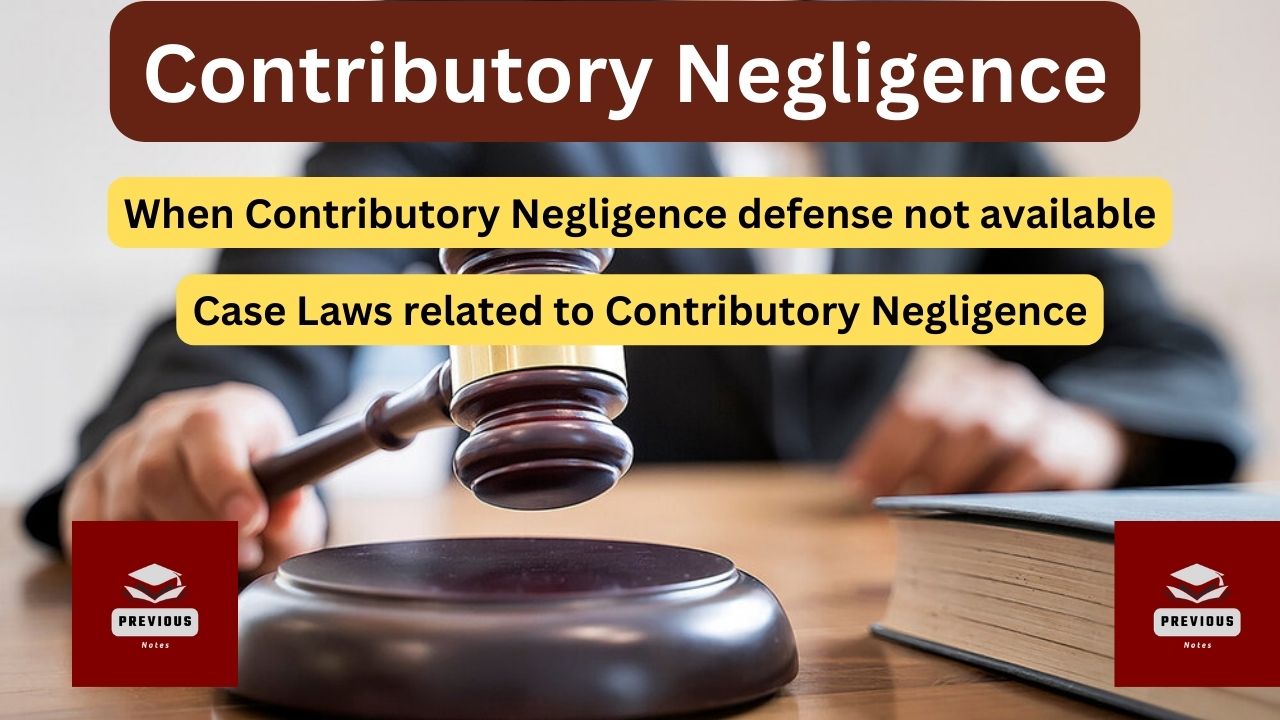- Contributory negligence is failure by a person (typically the plaintiff) to take reasonable care for his or her own safety, which contributes to the harm the person suffers.
- When the plaintiff by his own want of care contributes to the damage caused by the negligence or wrongful conduct of the defendant, he is considered to be guilty of Contributory Negligence.
- Contributory negligence occurs when a plaintiff (the person bringing the lawsuit) is found to have contributed to their own injury through their own negligent actions or failure to take reasonable care for their safety.
Table of Content:
Table of Contents
- Contributory Negligence
- Examples of Contributory Negligence
-
Main Principles or Doctrine Related to Contributory Negligence
- Doctrine of Apportionment of Damages
- Doctrine of Alternative Danger
- The Rule of Avoidable Losses
- Rule of Last Opportunity
- Contributory Negligence Defence When Not Available?
- Case Laws
Watch Vedio on Contributory Negligence:
Example 1: Pedestrian Accident
A pedestrian crosses the street against a red light and is struck by a car. The pedestrian sustains injuries and sues the driver for damages. However, the court finds that the pedestrian’s failure to obey the traffic signal constitutes contributory negligence. As a result, the pedestrian may be barred from recovering any damages from the driver, even if the driver was speeding.
Example 2: Slip and Fall in a Store
A customer in a grocery store slips on a wet floor and sustains injuries. The store had put up a “Wet Floor” sign, but the customer was distracted, looking at their phone, and did not see the sign. The court determines that the customer’s lack of attention contributed to their fall. Due to contributory negligence, the customer may be unable to recover any damages from the store.
Example 3: Car Accident
Two drivers are involved in a car accident. Driver A was speeding, while Driver B failed to signal before making a turn. Driver B sues Driver A for damages. The court finds that Driver B’s failure to signal contributed to the accident. Under contributory negligence, Driver B may be barred from recovering any damages from Driver A, despite Driver A’s speeding.
Example 4: Medical Malpractice
A patient suffers complications after a surgery and sues the surgeon for malpractice. However, it is revealed that the patient did not follow post-operative care instructions, such as taking prescribed medications or attending follow-up appointments. The court finds that the patient’s non-compliance with medical advice constitutes contributory negligence, potentially barring the patient from recovering damages from the surgeon.
Example 5: Workplace Injury
An employee is injured while operating machinery at work without using the required safety equipment, such as gloves or goggles, which were provided by the employer. The employee sues the employer for workplace injuries. The court determines that the employee’s failure to use the safety equipment provided constitutes contributory negligence, possibly preventing the employee from receiving any compensation from the employer.
Main Principles or Doctrines related to Contributory Negligence:
DOCTRINE OF APPORTIONMENT OF DAMAGES
The Doctrine of Apportionment of Damages is a legal principle used to distribute liability and damages among multiple defendants in proportion to their respective degrees of fault or responsibility for causing harm. This doctrine is particularly relevant in cases where more than one party is found to be at fault for the plaintiff’s injuries or losses.
Rural Transport Service v. Bezlum Bibi Case:
- Conductor of overloaded bus allowed passenger to travel by sitting on the roof of the bus.
- Due to negligence of driver, bus hit a tree and the passenger sitting on the tree died at the spot.
- It is clear that both plaintiff and defendant were negligent at their part.
- Mother of the passenger filed a suit to claim 16000 Rs.
- The compensation payable by the defendants was reduced by 50% to 8000 instead of Rs. 16000 by applying this rule.
DOCTRINE OF ALTERNATIVE DANGER
The Doctrine of Alternative Danger, also known as the Doctrine of Imminent Peril or the Emergency Doctrine, is a legal principle that provides a defense to a person who, in the face of sudden and unexpected danger, acts in a way that might otherwise be considered negligent. This doctrine acknowledges that in emergency situations, a person might not have the time or presence of mind to make the best or safest decision.
Example:
- A bus driver was driving negligently due to which accident could take place, B in apprehension jumped out of the bus and sustained injuries. A is liable to pay for the damages of B.
Jones v. Boyce
- plaintiff was a passenger in the defendant’s coach
- Coach was driven negligently
- In order to save himself, jumped off the coach and broke his leg.
- If he would have seated at seat, had not suffered that much damages.
- But plaintiff acted reasonably was not held negligent, no defence of contributory negligence can be claimed.
The Rule of Avoidable Losses:
The Rule of Avoidable Losses: also known as the duty to mitigate damages is a legal principle that requires a party who has suffered a loss (usually the plaintiff) to take reasonable steps to minimize that loss. This rule is commonly applied in contract law and tort law to ensure that the injured party does not passively allow their damages to increase unnecessarily.
For instance, a person injured in an accident should follow medical advice to recover as quickly as possible and avoid activities that could worsen their condition. Now, that person cannot claim damages for the worsened situation as he himself contributing to his injuries.
Rule of last opportunity
The “Rule of Last Opportunity,” also known as the “Last Clear Chance Doctrine,” is a legal principle that provides an exception to the strict application of contributory negligence. It allows a plaintiff to recover damages even if they were contributorily negligent, provided that the defendant had the last opportunity to avoid the accident but failed to do so.
Example:
Train and Pedestrian Incident:
- A pedestrian ignores warning signals and steps onto train tracks. The train conductor sees the pedestrian from a distance and has sufficient time to stop the train but fails to do so. The pedestrian may be able to recover damages under the Rule of Last Opportunity because the conductor had the last clear chance to avoid the accident.
Contributory Negligence defence when not available?
- Strict Liability: Contributory Negligence is not a defence in case of strict liability (and in absolute liability) cases though plaintiff was negligent.
- When defendant has sufficient time to recourse.
- When there is an imminent threat to life of plaintiff and due to his the plaintiff acted negligently.
- In case of children.
- In maritime law.
You May Also Like:
DOMESTIC VIOLENCE AS TORT | APPLICATION OF TORT LAW
Economic Tort | Business Tort: Application of Tort Law
Difference between intention and motive | In Tabular Format
Bolam Test | Bolam V. Friern Hospital Committee | Medical Negligence
Jacob Mathew V. State of Punjab Case Law | Medical Negligence
Medical Negligence in tort | Case Laws
Indian Penal Code MCQs Quiz: Section 1 to 5
Indian Panel Code MCQs Quiz on Section 511 and Attempt
IPC MCQs Quiz on Sec. 76 and Sec. 79 | Quiz on Mistake
Practice IPC MCQs online for free (Section 78)
Practice IPC MCQs Quiz for free | Section 81 MCQs | Necessity
Practice IPC MCQs online for free : Infancy (section 82-83)
Practice IPC MCQs Quiz for free | Section 81 MCQs | Necessity
Practice IPC MCQs Quiz for free | Section 84 MCQs | Insanity
Specific Principles of Criminal Law | LLM Previous Year Paper 2024 | CCSU
Specific Torts | LLM 4th Semester Previous Year Paper 2024 | CCSU
History and Basic Principles of Criminal Law | Previous Paper 2023
LLM Previous Year Paper 2023 | PRIVILEGED CLASS DEVIANCE
PENOLOGY PREVIOUS YEAR PAPER | LLM | CCSU
LLB Previous Year Paper 2023 | Constitutional Law II | CCSU
LLB Previous Year Paper 2023 | Legal and Constitutional History | CCSU
LLB Previous Year Paper 2023 | Jurisprudence II | CCSU
LLB Hindu Law Previous Year Paper 2023 | CCSU
LLB Hindu Law Previous Year Paper 2024| CCSU
Euthanasia in India, Right to die with Dignity
Right to Privacy Case Law Mr. X vs. Hospital Z
Federal Constitution Definition and key points
University of Madras vs. Shantabai,1954: Article 12 Case Law
Article 20 Fundamental Right with Case Laws
Article 19 Fundamental Right of Indian Constitution with 10 Case Laws
Article 358, 359 Fundamental rights during emergency
Parliamentary Privileges and Fundamental Rights with Case Laws
Article 14 Fundamental Right with Case Laws
Article 15 Fundamental Right with Case Laws
Article 12 Fundamental Right with Case Laws
DOMESTIC VIOLENCE AS TORT | APPLICATION OF TORT LAW
Crimes without Mens Rea? Statute without Mens Rea.
Definition of crime by various jurists, Criminology
Methods of Studying Criminology
All about Capital Punishment with Case Laws
IMPOSSIBLE ATTEMPT | ATTEMPT VS IMPOSSIBLE ATTEMPT
Difference between Preparation and Attempt
Tests to Determine Attempt and preparation | With Case Laws
Difference between intention and motive | In Tabular Format
Forms of Judicial Process: Adversarial & Inquisitorial
Crimes without Mens Rea? Statute without Mens Rea.


















Leave a Reply